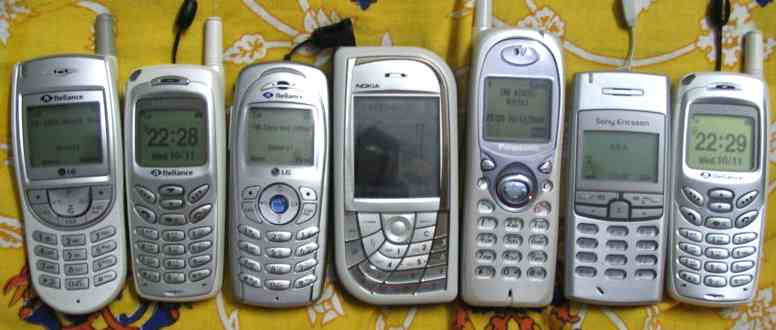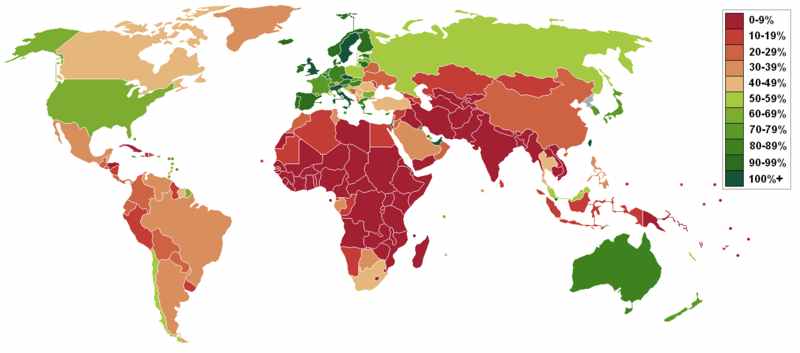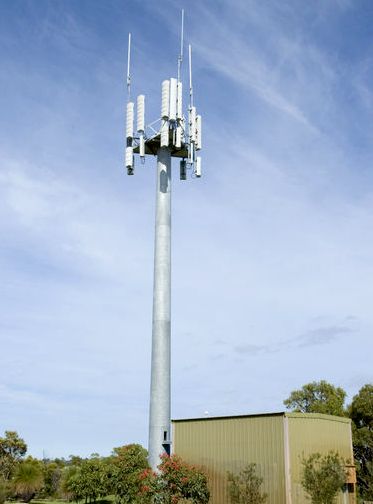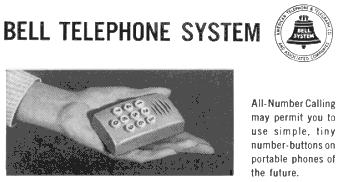|
MOBILE PHONES
|
||
|
HOME | BIOLOGY | FILMS | GEOGRAPHY | HISTORY | INDEX | INVESTORS | MUSIC | NEWS | SOLAR BOATS | SPORT |
||
|
A mobile or cell(ular) (tele)phone is a long-range, portable electronic device for personal telecommunications over long distances.
Most current mobile phones connect to a cellular network of base stations (cell sites), which is in turn interconnected to the public switched telephone network (PSTN) (the exception are satellite phones). Cellular networks were first introduced in the early to mid 1980s (the 1G generation). Prior mobile phones operating without a cellular network (the so-called 0G generation), such as Mobile Telephone Service, date back to 1945. Until the mid to late 1980s, most mobile phones were sufficiently large that they were permanently installed in vehicles as car phones. With the advance of miniaturization, currently the vast majority of mobile phones are handheld. In addition to the standard voice function of a telephone, a mobile phone can support many additional services such as SMS for text messaging, email, packet switching for access to the Internet, and MMS for sending and receiving photos and video.
Mobile phone parade
The world's largest mobile phone manufacturers include Audiovox, BenQ-Siemens, High Tech Computer Corporation, Fujitsu, Kyocera, LG, Motorola, NEC, Nokia, Panasonic (Matsushita Electric), Pantech Curitel, Philips, Sagem, Samsung, Sanyo, Sharp, Siemens SK Teletech, Sony Ericsson, T&A Alcatel and Toshiba.
The world's largest mobile phone operators include Orange SA, China Mobile and Vodafone.
There are also specialist communication systems related to, but distinct from mobile phones, such as Professional Mobile Radio. Mobile phones are also distinct from cordless telephones, which generally operate only within a limited range of a specific base station. Technically, the term mobile phone includes such devices as satellite phones and pre-cellular mobile phones such as those operating via MTS which do not have a cellular network, whereas the related term cell(ular) phone does not. In practice, the two terms are used nearly interchangeably, with the preferred term varying by location.
Worldwide deployment
Radio phones have a long and varied history that stretches back to the 1950s, with hand-held cellular radio devices being available since 1983. Due to their low establishment costs and rapid deployment, mobile phone networks have since spread rapidly throughout the world, outstripping the growth of fixed telephony.
In most of Europe, wealthier parts of Asia, Africa, the Caribbean, Latin America, Australia, Canada, and the United States, mobile phones are now widely used, with the majority of the adult, teenage, and even child population owning one. Taiwan had the highest mobile phone usage in 2005 at 111 subscribers per 100 people. Hong Kong has the highest mobile phone penetration rate in the world, at 127.4% in June 2006.[2] The total number of mobile phone subscribers in the world was estimated at 2.14 billion in 2005. Around 80% of world's population have mobile phone coverage as of 2006. This figure is expected to increase to 90% by the year 2010
At present India and China have the largest growth rates of cellular subscribers in the world. The availability of Prepaid or pay as you go services, where the subscriber does not have to commit to a long term contract, has helped fuel this growth on a monumental scale.
The mobile phone has become ubiquitous because of the interoperability of mobile phones across different networks and countries. This is due to the equipment manufacturers working to meet one of a few standards, particularly the GSM standard which was designed for Europe-wide interoperability. All European nations and most Asian and African nations adopted it as their sole standard. In other countries, such as the United States, Australia, Japan, and South Korea, legislation does not require any particular standard, and GSM coexists with other standards, such as CDMA and iDEN.
World mobile phone usage map
Mobile phone culture or customs
In fewer than twenty years, mobile phones have gone from being rare and expensive pieces of equipment used by businesses to a pervasive low-cost personal item. In many countries, mobile phones now outnumber land-line telephones, with most adults and many children now owning mobile phones . In the United States, 50% of children own mobile phones.[3] It is not uncommon for young adults to simply own a mobile phone instead of a land-line for their residence . In some developing countries, where there is little existing fixed-line infrastructure, the mobile phone has become widespread. According to the CIA World Factbook the UK now has more mobile phones than people [4].
With high levels of mobile telephone penetration, a mobile culture has evolved, where the phone becomes a key social tool, and people rely on their mobile phone address book to keep in touch with their friends. Many people keep in touch using SMS, and a whole culture of "texting" has developed from this. The commercial market in SMS's is growing. Many phones even offer Instant Messenger services to increase the simplicity and ease of texting on phones. Cellular phones in Japan, offering Internet capabilities such as NTT DoCoMo's i-mode, offer text messaging via standard e-mail.
The mobile phone itself has also become a totemic and fashion object, with users decorating, customizing, and accessorizing their mobile phones to reflect their personality. This has emerged as its own industry. The sale of commercial ring-tones exceeded $2.5 billion in 2004 [5].
Mobile phone etiquette has become an important issue with mobiles ringing at funerals, weddings, movies, and plays. Users often speak at increased volume which has led to places like bookshops, libraries, movie theatres, doctor's offices, and houses of worship posting signs prohibiting the use of mobile phones, and in some places installing signal jamming equipment to prevent usage (although in many countries, e.g. the United States, such equipment is illegal). Transportation providers, particularly those doing long-distance services, often offer a "quiet car" where phone use is prohibited, much like the designated non-smoking cars in the past. Mobile phone use on aircraft is also prohibited, because of concerns of possible interference with aircraft radio communications [6]. Most schools in the U.S prohibit cell phones due to the high amount of class disruptions due to their use, and due to the possibility of photographing someone (without consent).
Camera phones and videophones that can capture video and take photographs are increasingly being used by companies like Scoopt to cover breaking news. Stories like the London Bombings, the Indian Ocean Tsunami and Hurricane Katrina have been reported on by camera phone users on photo sharing sites like Flickr.
In Japan, cellular phone companies provide immediate notification of earthquakes and other natural disasters to their customers free of charge. In the event of an emergency, disaster response crews can locate trapped or injured people using the signals from their mobile phones; an interactive menu accessible through the phone's Internet browser notifies the company if the user is safe or in distress. Mobile phone features
Invented in 1997, the camera phone is now 85% of the market. Mobile phones also often have features beyond sending text messages and making voice calls—including Internet browsing, music (MP3) playback, personal organizers, e-mail, built-in cameras and camcorders, ringtones, games, radio, Push-to-Talk (PTT), infrared and Bluetooth connectivity, call registers, ability to watch streaming video or download video for later viewing, and serving as a wireless modem for a PC.
In most countries, the person receiving a cellular phone call pays nothing. However, in China (including Hong Kong), Canada, and the United States, one can be charged per minute.
Mobile phone tower
Technology
Mobile phones and the network they operate under vary significantly from provider to provider, and even from nation to nation. However, all of them communicate through electromagnetic radio waves with a cell site base station, the antennas of which are usually mounted on a tower, pole, or building.
The phones have a low-power transceiver that transmits voice and data to the nearest cell sites, usually 5 to 8 miles (approximately 8 to 13 kilometres) away. When the cellular phone or data device is turned on, it registers with the mobile telephone exchange, or switch, with its unique identifiers, and will then be alerted by the mobile switch when there is an incoming telephone call. The handset constantly listens for the strongest signal being received from the surrounding base stations. As the user moves around the network, the mobile device will "handoff" to various cell sites during calls, or while waiting (idle) between calls it will reselect cell sites.
Cell sites have relatively low-power (often only one or two watts) radio transmitters which broadcast their presence and relay communications between the mobile handsets and the switch. The switch in turn connects the call to another subscriber of the same wireless service provider or to the public telephone network, which includes the networks of other wireless carriers.
The dialogue between the handset and the cell site is a stream of digital data that includes digitized audio (except for the first generation analog networks). The technology that achieves this depends on the system which the mobile phone operator has adopted. Some technologies include AMPS for analog, and D-AMPS, CDMA2000, GSM, GPRS, EV-DO, and UMTS for digital communications. Each network operator has a unique radio frequency band. Controversy
Health controversy
As with many new technologies, concerns have arisen about the effects on health from using a mobile telephone. There is a small amount of scientific evidence for an increase in certain types of rare tumors (cancer) in long-time, heavy users. More recently a pan-European study provided significant evidence of genetic damage under certain conditions. Some researchers also report the mobile phone industry has interfered with further research on health risks. So far, however, the World Health Organization Task Force on EMF effects on health has no definitive conclusion on the veracity of these allegations. (See also electromagnetic radiation hazard.) It is generally thought, however, that RF is incapable of producing any more than heating effects, as it is considered non-ionizing radiation; in other words, it lacks the energy to disrupt molecular bonds such as occurs in genetic mutations.
Sperm Production
Mobile phones have also been identified as a cause of reduced sperm production in men. Microwaves emitted by the phones reduce the number, mobility and quality of sperm by almost half in the heaviest users, to the point where some men may become infertile, scientists say. This could have devastating consequences for fertility rates around the world. Almost a billion people around the world use mobile phones, and the number is growing. Even a small effect on fertility could result in millions of men being rendered childless.
Driving controversy
Another controversial but more lethal health concern is the correlation with road traffic accidents. Several studies have shown that motorists have a much higher risk of collisions and losing control of the vehicle while talking on the mobile telephone simultaneously with driving, even when using "hands-free" systems. Other studies have shown that using a mobile phone while driving poses the same risk as someone operating a vehicle while under the influence of alcohol. Four U.S. states and many countries have now restricted or prohibited the use of mobile phones while driving. In the UK and in Israel, driving whilst holding a mobile phone to ones ear is illegal.
Potential danger during electrical storms
In 2006, it was reported [7] that mobile phone users suffer much more serious lesions than non-users, in case of being struck by lightning during an electrical storm. Cell phones do not, however, present the danger of a land line during an electrical storm; whereas wires can carry a lightning strike to a nearby telephone user, cell phone signals are immune to such danger. Security concerns
Early mobile phones were limited in their security features. Some problems with these models were "cloning", a variant of identity theft, and "scanning" whereby third parties in the local area could intercept and eavesdrop in on calls. Analogue phones could also be listened to on some radio scanners.
Although more recent digital systems (such as GSM) have attempted to address these fundamental issues, security problems continue to persist. Vulnerabilities (such as SMS spoofing) have been found in many current protocols that continue to allow the possibility of eavesdropping or cloning.
It should be noted that on a technical level, CDMA is more secure then GSM and TDMA. This is due to the fact that all calls are separated onto their own channel and encoded with a unique encryption code. In all though, digital is much more secure then analog systems.
Mock-up of the "portable phone of the future," - a 60s Bell System ad shows a portable uncannily like a modern mobile
Mobile communication studies
Since 2002 there has been an enormous increase in academic research regarding the social impact of mobile phones. Books include:
Future prospects
This article may contain original research or unverified claims.
There is a great deal of active research and development into mobile phone technology that is currently underway. Some of the improvements that are being worked on are:
Use of a mobile phone is prohibited in some rail carriages
Terminology
Mobile phone terms
3G phone
A mobile phone which uses a third-generation technology network that has greater bandwidth allowing faster data downloads and face-to-face video calling.
BlackBerry
BlackBerry by Research in Motion is a mobile device with both phone functionality and push based email functionality
Brick or Candybar Style
1. A large, heavy, and usually obsolete wireless mobile phone such as the Motorola International 3200. (also Cinderblock or Shoebox)
2. A mobile phone of a solid form factor. Originally many Nokia models were of this design. (also candybar)
Camera phone
A mobile phone equipped with a digital optical camera. The camera may be capable of capturing still images and/or video.
Clamshell or flip phone
A mobile phone of a form factor resembling the shell of a clam with the ability to open up in the same way. Some earlier flip phones had a small brick-like form factor with a hinge at the bottom of the phone that was attached to a flat piece of plastic which flipped up to cover the keypad but left the display screen exposed. It's worth noting that 'Flip Phone' is a trademark of Motorola, filed under registration number 2157939 at the US Patent and Trademark Office.
Slider or slide phone
A mobile phone with a sliding form factor. Usually, the display slides over the keypad to prevent accidental dialing. Some models are designed so that the keypad slides over the display screen.
Cell phone, cellular phone, or cell
Term used currently in the United States and Canada (and in other countries as well during the 1980s) to refer to most mobile phones. It technically applies specifically to mobile phones which use a cellular network. In developing mobile phone technology, American electrical engineers were confronted by the challenge of achieving a smooth handoff from one radio antenna to the next. After the name "cell" was applied to the zone covered by each antenna, it was a natural choice for them to apply the term "cellular" to both the technology and the phones that ran on it.
Dual front
Is a design aspect which means that a phone can have two sides which are contrasting in use, i.e. camera-like design on one side, and general phone design on other.
Dual NAM
Is a feature that allows two mobile numbers from the same cellular vendor to be associated with one mobile phone. The Dual Nam feature is useful for people who have a business phone number and a personal phone number on single mobile phone. Listed below are some information, guidelines, and instructions for those interested in using Dual NAM.
How to order Dual NAM:
Handset
A term used by manufacturers to refer to a mobile phone. Also commonly used by industry insiders.
Hands-free car kit
Mobile phone accessory used to talk while keeping hands on the steering wheel.
Handy
An English word adopted by German speakers to refer to mobile phones.
Hand phone
Term used currently in Asia-Pacific countries such as South Korea, Singapore, Malaysia, and Indonesia to refer to most mobile phones.
Keitai
The Japanese word for mobile phone, often used by any one living in Japan.
Mobile phone
A term covering cellular phones, satellite phones and any other phones giving wide-ranging mobility used in most English-speaking countries. In some English-speaking countries such as the United Kingdom and Australia, common usage refers specifically to phones using the cellular network.
Pelephone
(he. פלאפון) The slang term for a mobile phone in Israel. It is a brand name derived from the words Pele (פלא) Telefon (טלפון). These are the English words miracle and telephone respectively.
Ringtone
A song or tune that is played to alert the user that a mobile phone is receiving a call.
Satellite phone
A mobile phone which communicates with a satellite rather than a land-based network.
Unlock
To enter a code into a GSM phone which has a subsidy lock to one operator so that it will accept a Subscriber Identity Module from another operator.
Wireless phone
A term that generally refers to a Wi-Fi VoIP phone but is sometimes used by the mobile phone industry to describe mobile phones. Related non-cellphone systems
Cordless phone (portable phone)
Cordless phones are standard telephones with radio handsets. Unlike mobile phones, cordless phones use private base stations that are not shared between subscribers. The base station is connected to a land-line.
Professional Mobile Radio
Professional mobile radio systems are very similar to cell phone systems and attempts have even been made to use TETRA, the international digital PMR standard, to implement public mobile networks, but normally PMR systems are sufficiently separate from the phone network to not really be considered phones but rather radios.
Radio phone
This is a term which covers radios which could connect into the telephone network. These phones may not be mobile; for example, they may require a mains power supply. Also, they may require the assistance of a human operator to set up a PSTN phone call.
LINKS and REFERENCE
FIND YOUR PERFECT PHONE A - Z
No matter what style, design or features you need on your phone, it pays to shop for a good deal ...................
Finding the right mobile phone and airtime package from numerous high street and online dealers can prove to be an overwhelming challenge. However, there’s more to a search than just finding a good looking phone. You need to ensure you get a reliable service and sensibly priced airtime. We therefore recommend you see these Mobile Phone Dealers before buying.
Mobile refreshment for better communicators ......
(330ml Earth Can)
This material and any views expressed herein are provided for information purposes only and should not be construed in any way as a prospectus or offer. Please contact the company concerned for information of any business opportunity or specific program. Before investing in any business, you must obtain, read and examine thoroughly its disclosure document or offering memorandum.
|
||
|
This
website
is Copyright © 1999 & 2008 NJK. The bird |
||
|
AUTOMOTIVE | BLUEBIRD | ELECTRIC CARS | ELECTRIC CYCLES | SOLAR CARS |





